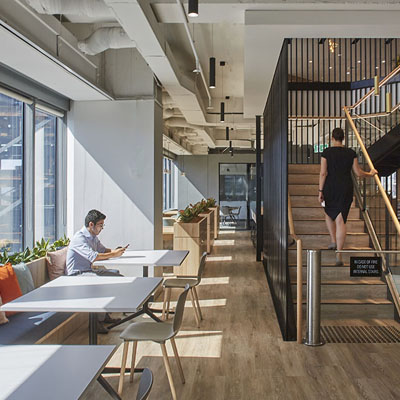
Written by Angela Ferguson in partnership with Business Interiors.
Lately it seems that the people’s experience of the workplace can be divided into two, almost religious eras – Before Covid (BC) and After Lockdowns (AL). Before Covid people generally came to the office to undertake collaborative and focused work in equal measure, and inhabited spaces that were predominantly open plan with some built environment available for meetings, quiet working, training and other activities.
It was important that the workplace supported both collaborative and focused work, often through agile furniture solutions such as high-backed lounges and mobile screens situated within the open plan environment. If people were lucky their workplace included social spaces – cafes, breakrooms, or staff areas where they could connect with colleagues over a coffee or a meal – yet these were often the privilege of larger organisations and tech companies with budget to spend.
Before the pandemic, social interaction between employees was viewed by organisations as an ‘add on’ but not a necessity to their company success. In our research it was clear that, in order of preference, prior to the pandemic, people wanted to collaborate, focus and then socialise with their colleagues when they were working in the office.

After Lockdowns, as people’s hybrid working patterns started to emerge, the meaning and purpose of the workplace experience, and the resultant physical environment has changed significantly. Social spaces are now the key to attracting staff back to the office, and to creating a workplace experience that has a new meaning and purpose After Lockdowns. A loss of human connection and increased psychological distress caused by the pandemic contributed to an overall decline in good mental health in working Australians.
Supporting this, a report published by The Australian Institute and the Centre for FutureWork indicated that 15% to 45% of mental health issues by employed people are attributable to conditions within their workplace. These conditions can include unhealthy working environments, stress and excessive workloads, as well as absenteeism and presenteeism putting pressure on colleagues. As people now start to settle into new ways of hybrid working, and blending working from home with working from the office, smart organisations are looking at the design of their workspaces and how this aligns with differing needs of the people who inhabit it.
When considering the After Lockdown experience of work our research has found that different activities can be more effective, depending on where people are located:
Activities more effective when undertaken at the office:
- creative teamwork, planning, problem solving, ideas generation, innovation
- peer to peer learning, teaching, mentoring
- building relationships, networking, team building, creating social connections
- onboarding
Activities more effective when done at home or in a quiet space:
- deep, focused, independent work
- project work when teams are in dispersed locations
- large town hall meetings or online workshops if they are not in person
- hybrid board/executive meetings

There is now a new emphasis on the social aspects of work. As workplace loneliness becomes an increasingly significant issue, using the workplace as an important social connecter is critical. Having strong social bonds with our colleagues has been proven to improve wellbeing, and peoples’ experience during the pandemic and lockdowns has underpinned this. In our research and work with leading businesses, we are seeing a new order of importance, with the workplace environment emphasising social, collaborative then focused work.
People want to come to the office to connect with each other relationally and to collaborate on projects and work product. They still want to be able to undertake focused work from time to time, even though it can predominantly be undertaken when working from home. The ideal workplace will really leverage this, encouraging behaviours that work well and supporting new, desired social connections and habits. This is where I enjoy collaborating with innovative suppliers like Business Interiors to select quality furniture that motivates teams to come together in well-designed spaces that inspire and support their productivity, social needs, and wellbeing. In a fast paced, rapidly changing world, the workspaces we inhabit have an important role to play, now more than ever.
As workplaces take on a new identity in a post-pandemic world, Business Interiors is enabling engagement, collaboration and culture with intelligent furniture solutions that address the evolving needs of employees and organisations. Contact our Business Interiors expert team to enhance your workplace – we can help with everything from a small refresh to a complete fit-out.






